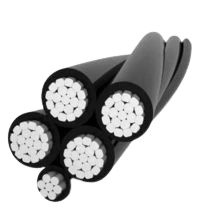BIS Certification for Aerial Bunched Cables IS 14255 :1995

Product Description
Aerial Bunched Cables (ABC) under IS 14255 : 1995 are designed for overhead electrical power distribution systems, typically used in areas where underground cable installation is not feasible. These cables are made to operate under working voltages up to and including 1100 volts, offering an efficient and safe alternative for power distribution in urban, rural, and industrial environments.
The cables feature multiple conductors (typically made of aluminum or copper), bundled together, and are insulated with a weather-resistant material, making them ideal for use in outdoor conditions. BIS certification ensures these cables meet the necessary safety, performance, and durability requirements, ensuring their reliability and safety in electrical networks.
Introduction
The BIS certification for Aerial Bunched Cables under IS 14255 : 1995 is mandatory for cables used in overhead power distribution systems with working voltages up to 1100V. The standard defines the necessary requirements for cable design, materials, insulation, and safety features to ensure these cables perform optimally in outdoor, exposed conditions. Compliance with BIS certification ensures that these cables meet the required standards for use in residential, commercial, and industrial areas, improving the safety and reliability of electrical networks.
Why is BIS Certification Necessary for Aerial Bunched Cables?
BIS certification for Aerial Bunched Cables is necessary to ensure that the cables meet the required safety, quality, and performance standards. These cables play a critical role in electrical distribution systems, especially in areas where underground cables are not an option. Certification ensures that these cables can safely carry electrical loads while withstanding environmental conditions, such as exposure to sunlight, rain, and temperature variations. Compliance with IS 14255 : 1995 ensures that manufacturers adhere to consistent quality, enhancing the reliability and safety of the power distribution network.
Overview of Indian Standard IS 14255 : 1995
Indian Standard IS 14255: 1995 outlines the specifications for Aerial Bunched Cables used in power distribution systems with working voltages up to 1100 volts. The standard specifies material requirements, including the use of aluminum or copper conductors, ensuring that the cables can handle the necessary electrical load. Cables must be insulated with durable, weather-resistant materials to withstand outdoor conditions like moisture, UV rays, and extreme temperatures. The standard also defines the mechanical strength of the cables, ensuring they can endure stresses during installation and operation without damage. Safety features are required to prevent short circuits, damage, and fire hazards. Additionally, test methods for insulation resistance, tensile strength, and temperature endurance are outlined to ensure the cables meet the necessary electrical and mechanical properties. Compliance with IS 14255: 1995 guarantees that the cables are reliable and safe for use in power distribution systems.
Process for BIS Certification
The BIS certification process for Aerial Bunched Cables
under IS 14255 : 1995 involves several steps to evaluate a product's compliance
with the standards. The general process includes:
- Application Submission: Manufacturers submit an application
for BIS certification along with the required documentation, including the
product specifications and manufacturing process details.
- Documentation Review: BIS reviews the submitted application
and documentation to verify that the manufacturer complies with the standard’s
requirements.
- Factory Inspection: BIS officials visit the manufacturing
facility to inspect the production process, quality control measures, and
testing facilities.
- Sample Testing: Samples of the aerial bunched cables are
tested in BIS-approved laboratories to ensure they meet the specifications of
IS 14255 : 1995.
- Certification Grant: Upon successful inspection and testing,
BIS grants certification, and the manufacturer is authorized to use the ISI
mark on their products.
Documents Required for BIS Certification
To apply for BIS certification, manufacturers must submit the following documents:
- Application form
- Details of the manufacturing process
- Quality control procedures
- Test reports from BIS-approved laboratories
- Factory layout and equipment specifications
- Business registration documents
- Product specifications and technical details
- Declaration of conformity to IS 14255 : 1995
In some cases, additional environmental and safety compliance documents may be required depending on the product.
BIS ISI Mark Certification Costing And Timeline
To Know The Process in Detail, Please Visit:
Conclusion
BIS certification for Aerial Bunched Cables under IS 14255 : 1995 is vital to ensure that these cables meet the required standards for safety, performance, and durability in power distribution systems. By obtaining BIS certification, manufacturers ensure that their products are reliable, safe, and compliant with Indian regulations. Compliance with the certification also guarantees that these cables are suitable for use in overhead electrical networks, reducing the risk of failures and enhancing the overall efficiency of the electrical grid. EVTL India offers consultancy services to guide manufacturers through the BIS certification process, ensuring efficient submission, documentation, and compliance. With extensive experience in handling BIS portal submissions and regulatory requirements, EVTL India helps manufacturers streamline the certification process, ensuring consistent product quality and market acceptance in India and internationally.
Free Call Back
Latest News & Update
📅 BIS Critical Component List (CCL) Updates for Solar PV Modules
🕒 BIS Fee Concessions for MSMEs and Startups | EVTL India
📅 Guidelines for Implementation of Essential Requirements for Security of CCTV
🕒 Machinery and Electrical Equipment Safety (Omnibus Technical Regulation) Order, 2024
🕒 Extension of Timeline for Filing Annual Returns by Battery Producers
📅 Extension of Timeline for Filing Quarterly and Annual Returns for E-Waste
🕒 Extension of Concurrent Running Period for IS 302-1: 2008 and IS 302 (Part 1): 2024























